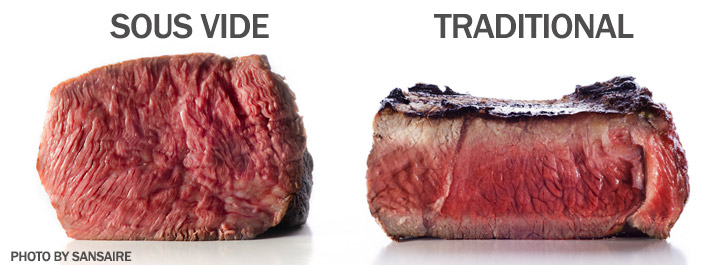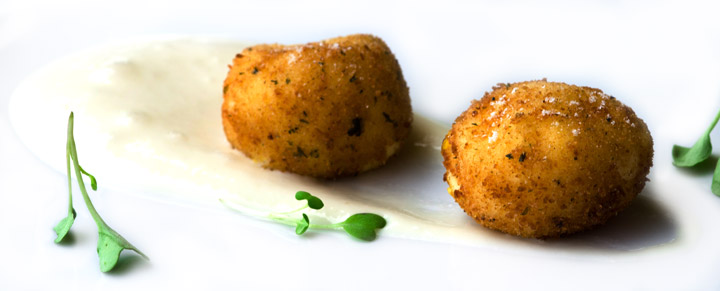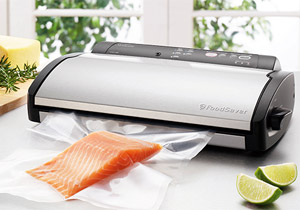Sous Vide Overview
What is Sous Vide?
Parts of this course were adapted from Sous Vide Cooking: An Introduction by Douglas Baldwin
Sous vide is French for “under vacuum” and describes the cooking of raw ingredients in heat-stable, vacuumed pouches at precise temperatures. Despite its name, precise temperature control is more important when cooking sous vide than vacuumed packaging. The main benefit of sous vide is that it ensures the food is evenly cooked from edge to edge, to desired doneness, without overcooking the outside and maintaining moisture. Also, foods don't overcook if they stay longer in the sous vide bath so they can be conveniently served when you are ready.

Sous vide cooking has been used in the world’s top restaurants since the 1970s, was extensively studied by food scientists in the 1990s, and started showing up in home kitchens in the late-2000s. Today, most high end and molecular gastronomy restaurants use sous vide in their kitchens.
In the 1960s, French and American engineers realized that cooking meat in vacuum bags at relatively low temperature resulted in superior texture compared to a traditionally-cooked product. In 2008, trendsetting chef Thomas Keller released "Under Pressure: Cooking Sous Vide" a guide to using the technique, and it quickly became popular at restaurants across the United States.
Of course, the sous vide technique had been used in other countries to greater extent in previous years, but the rise of sous vide in the United States arguably popularized the technique for home use. Sous vide cooking equipment used to be over $1000 just a few years back but now they are a few hundred dollars and are designed for home use.
So why is sous vide so popular? Precise temperature control has several benefits: it allows almost-perfect reproducibility; it gives greater control over doneness than traditional cooking methods; it ensures the food is evenly cooked from center to edge; the food can be pasteurized and made safe at lower temperatures — so a Sous Vide steak doesn’t have to be cooked well-done to be safe; and tough cuts of meat can be made tender and still be a medium or a medium-rare doneness. Vacuum-sealing allows for efficient heat transfer from the water (or steam) to the food, it increases shelf-life by eliminating the risk of recontamination during storage, it helps inhibit off-flavors from oxidation, and it prevents evaporative losses of flavor volatiles and moisture during cooking.
The Basics of Sous Vide
Three different techniques combine to define "sous vide" cooking.
#1: Low-temperature cooking
At its most basic, sous vide cooking doesn't even require vacuum-bagging or using complicated circuitry to control temperature. The basic idea is simple: water transfers heat much more effectively than air does, so instead of cooking a steak at 350°F/176°C in the oven, why not cook it at 135°F/57°C in a water bath?
Low temperature cooking is essential to sous vide as it provides higher succulence. At low temperatures, the cell walls in food do not burst. When cooking meat, the tough collagen in connective tissue can be hydrolysed into gelatin without overheating the proteins to a point that they denature too much, toughen and lose moisture. When cooking vegetables, low temperatures in sous vide cook thoroughly but maintain a firm and crisp texture.
One drawback of sous vide low temperature cooking is that you don't get the flavors and crust from browning. Maillard reaction, the process that causes browning and the distinguished flavor and crust of a grilled steak only happens at much higher temperatures. But this is solved by adding one more step after cooking: searing.
Well-known food and science writer Kenji Lopez-Alt tried simply tossing a few steaks into a cooler full of hot water and found the results were practically identical to steaks cooked with much more expensive equipment. Some applications require more precise temperature control.
#2: Precision-temperature cooking
Why does precise temperature control matter? Because a single degree in the wrong direction with eggs for example, can mean the difference between a perfectly soft-boiled egg and a runny mess. Other proteins, such as fish or chicken, are also sensitive to small changes in temperature. And finally, knowing exact cook temperatures and times ensures that your food is safe to eat and determines expected shelf life. Tables with food type, cooking time and temperature have been created by scientists by accurately calculating microbial activity based on these parameters.

For a beautiful example of a perfectly-cooked egg yolk, see this recipe for Sous Vide Egg Yolk Croquette with Gruyere Foam.

#3: Vacuum Sealing
 Although sous vide technically means "under vacuum," many sous vide preparations don't require a vacuum sealer at all. But vacuum sealing has its benefits:
Although sous vide technically means "under vacuum," many sous vide preparations don't require a vacuum sealer at all. But vacuum sealing has its benefits:
- Vacuum-sealing allows for efficient heat transfer from the water (or steam) to the food.
- It prevents evaporative losses of flavor volatiles and moisture during cooking. Enclosed spices and ingredients added transmit their flavor more intensely. It retains all juices from proteins.
- It helps inhibit off-flavors from oxidation. For example, fat in meat can become rancid when exposed to air for a long time.
- It increases shelf-life by eliminating the risk of re-contamination during storage if food is going to be cooked, stored and reheated.





 (4 votes, average: 3.25)
(4 votes, average: 3.25)
